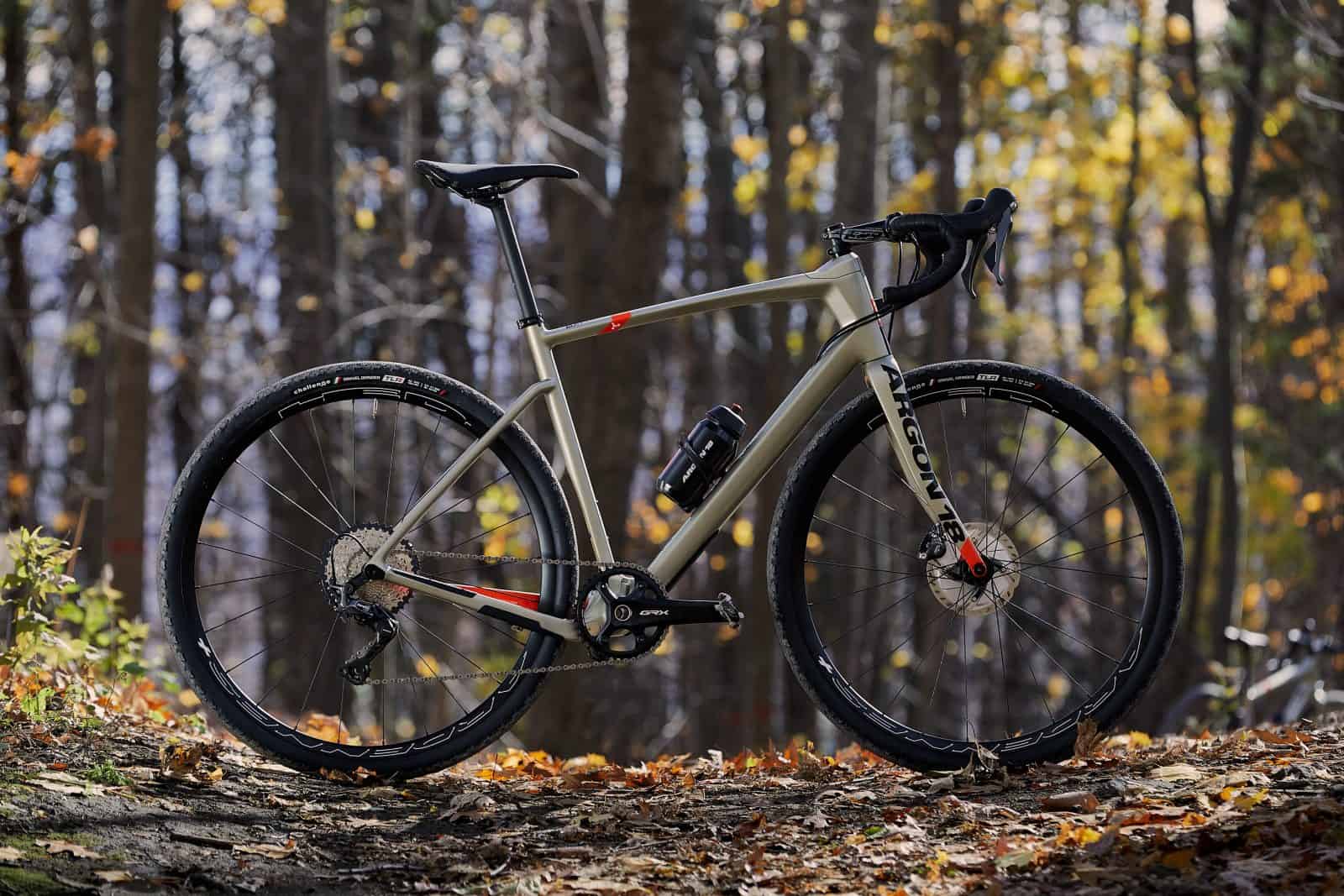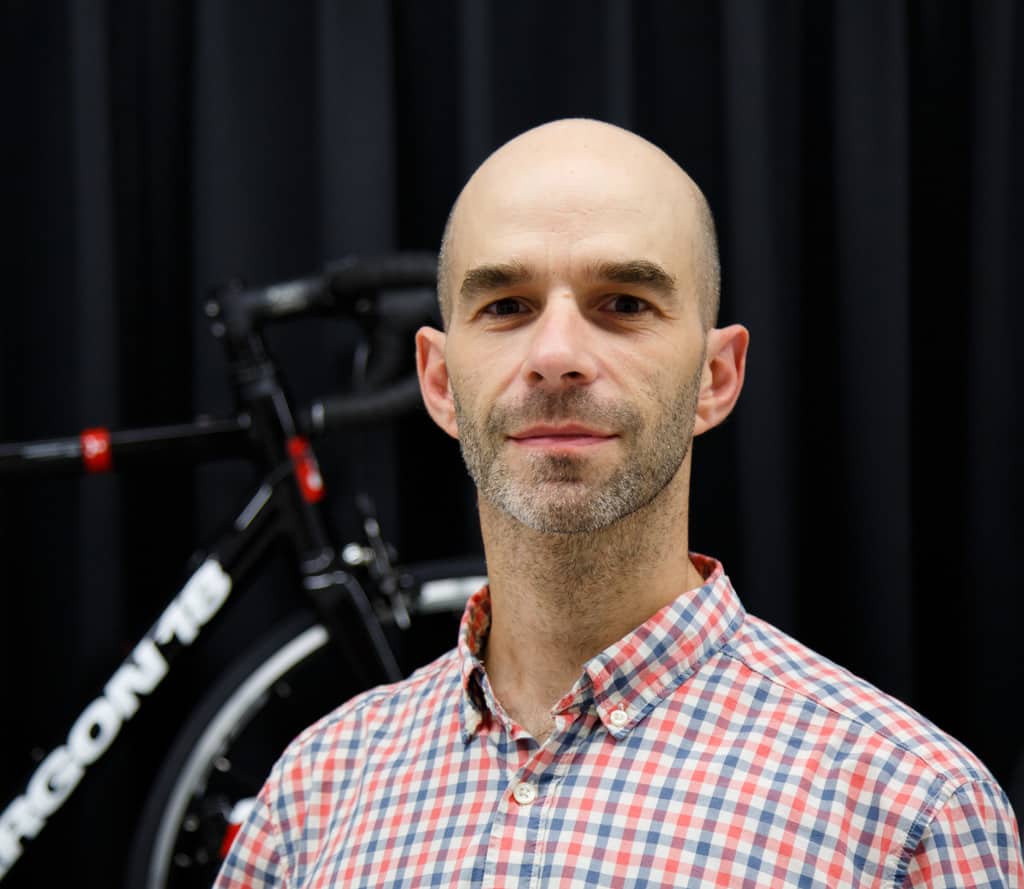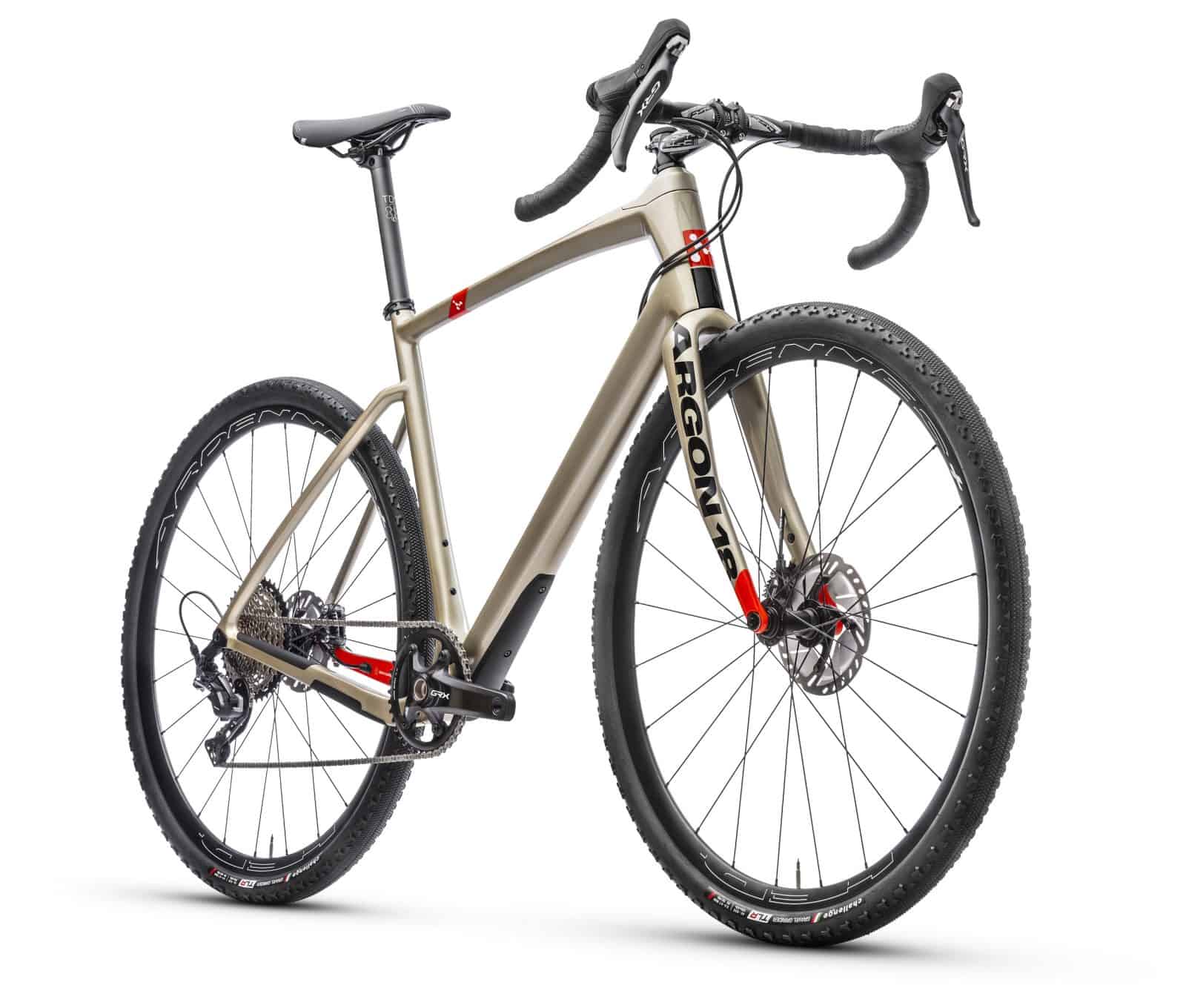Argon 18 is a brand that takes racing and aerodynamics very seriously. But as it turns out they also care a lot about comfort and a Dark Matter gravel bike is a great example of that approach. I got the opportunity to talk to Martin Faubert from Agron 18 about the Dark Matter bike and in the process, I also learned a lot about what can be done to make a carbon frame really comfy.
CyclingAbout: Can you tell me a little bit more about yourself Martin?
Martin: Yes, my name is Martin Faubert and I am VP of Product at Argon 18. I’ve worked here for over 11 years now, starting as a designer – my background is in industrial design. I was the first person in our R&D team because before that everything was done by Gervais Rioux, founder of Argon 18. He had consultants, but in general, he was doing all the work. As the company grew, he realized that he needed a team to collaborate on product development. Now I manage a team of 8 people: engineers, designers, product managers, and art directors. We have another 9 people working on the Notio electronic sensor that we specially developed to measure aerodynamic efficiency (CyclingAbout: it measures your drag coefficient in real-time as you ride so you can optimize your position and bike equipment).
CyclingAbout: Wow, this sounds big…
Martin: Yes, it sounds big but we are still a small company based in Montreal, with about 45 employees between operations, marketing, accounting, and product development. We are very focused on product development with almost 30% of our staff dedicated to it.
CyclingAbout: OK, let’s talk a little bit more about Argon 18 brand. Can you explain the idea behind the brand? Is it all about making the most aerodynamic bikes on the market?
Martin: Yes, we are focused on that, but it is tough to test all the bikes out there to see if we’ve succeeded! But yes, aero is a major topic at Argon 18. We have one person on CFD simulation full-time – this is basically a virtual wind tunnel. We also are doing a lot of development in track and in triathlon, so areas where aerodynamics is very important. Gervais Rioux, our founder who was an Olympic athlete, after retiring and running a bike shop, decided to make his own bikes in 1999. This was when triathlon was picking up traction, and so there was the need for better on-bike integration for improved aerodynamics, but also a stiffer front end for better performance. So in 2008, he launched the E-114 triathlon bike, which went on to win the Eurobike design award. This was a big milestone for the company and set the theme of aerodynamics for us, but at the core, we want to create the best product that balances aerodynamics with stiffness, comfort, and weight of the bike. We want to create a holistic product that offers the ultimate performance for the rider.
This was also true with the Dark Matter, which we designed for gravel. This was something different for us, but our background is racing so we wanted to develop a race gravel bike – not an adventure or bikepacking bike. We took all the knowledge we had about racing and brought it to dirt.
CyclingAbout: OK, let’s talk more about the Dark Matter. For me, the most unique thing about this bike is the bend in the fork. It looks like an old steel fork and it bends differently (forward rather than backward). Why did you go with that kind of design and is it better in terms of compliance than a traditionally-shaped fork?
Martin: Just before starting work on the Dark Matter we finished the development of a new Endurance bike called the Krypton. If you look at this bike you will also see the same bend in the fork. Basically, the Dark Matter was based on the Krypton design. When thinking about the Krypton we wanted to make the most comfortable bike – without gimmicks. We knew that we had a very good understanding of carbon fiber and how we can play with the topology of each tube and junction, so this allowed us to engineer as much compliance as possible. Suspension systems and other mechanical solutions like that add weight, and complexity and are prone to wear and tear, so we did not want to have that on our racing bike. We wanted a very efficient bike. And on a gravel bike, you can put large volume tires and this will really give you the comfort and traction that you need. I am simply not convinced that all those suspension solutions will make the rider go faster. They might add some comfort but at the cost of efficiency.
But yes, we also wanted the Dark Matter to be comfortable, so to reach the final design we completed around 45 computer simulations of the frame, benchmarking different features (different seat stay shapes, different tube shapes, different junction points) and in the end, we focused on the iterations that were working the best. The main key feature is, of course, the fork you have mentioned, but also the seat stay junction is low – this was not as popular a solution when we first launched the Krypton. Also, the specific shape of the seat stays allows them to bend outward giving just a little more compliance. So we have chosen the best solutions in terms of comfort without losing the power transmission of the bike.
CyclingAbout: So, if I understand you correctly, you were experimenting with different fork shapes and choose the forward-bend solution because it was the best in terms of compliance?
Martin: Yes, this shape creates a flexing point. A straight fork will not flex because there is no place where it can flex. Yet when you bend the fork it will flex and absorb some of the vibrations. The bend itself is made in a way that will increase the flex without impacting the handling of the bike. It was critical for us not to move the axle position but simply to create a fork that would improve compliance.

CyclingAbout: Do you somehow measure the compliance of the Dark Matter frame?
Martin: Yes, alongside our in-house aerodynamics testing we have devised our own way of testing the comfort of the frame. Static deformation is one thing, but when you are riding the bike you are experiencing all sorts of road vibration. We wanted to be able to measure what is absorbed by the frame in those situations and we did that both for the road bike and the gravel bike. As you can see in the video, our frame can flex quite a lot, absorbing a lot of vibrations before they hit the rider.
CyclingAbout: Let’s talk more about the rear triangle of the bike. It seems that there are two approaches to making it more comfortable:
First is to make the seat stays as long as possible (so ideally you bend them and the cross-section is as close to the top tube as possible)
The second is to make them short and connect them with the seat tube as low as possible.
You went with the second one. What are the benefits of it and is it true that your approach is more for the flexing of the seatpost than for allowing the wheel to move up and down (which in theory also improves traction)?
Martin: The configuration that can make the frame absorb the most vibrations is putting the seat stays low. When you hit a bump the seat stays push the seat tube, so when you connect them at the junction of the seat tube and top tube you don’t have space for any movement because that junction is rigid. But if you lower the seat stay connection and you are in the middle of the seat tube then the seat tube can flex forward. At the same time, the weight of the rider when they hit a bump will push the saddle downwards. The combination of those two forces allows the seat stays to flex outward and the chainstay to flex in a vertical direction and thus allows for vibration absorption. When you connect the seat stays with the seat tube at the top tube level you will get a slightly stiffer frame but at the same timeless comfortable.
CyclingAbout: On the topic of flex. What do you think about the solutions like the Cannondale Kingpin suspension system that uses a mechanical pivot point to increase the amount of flex at the rear triangle of the bike and, as a result, improve not only comfort but also the traction of the rear wheel?
Martin: I don’t want to say that Cannondale’s solution is not good. It’s a different approach. I am 100% sure that the rear wheel vertical movement will be greater on Cannondale’s bike. But when you are using big tires with the right air pressure you can gain a lot of traction without the need for additional mechanical suspension. We decided that we don’t want to use any additional systems that could compromise the pure performance/power transfer of the bike. Also every moving part in a bicycle is subject to problems, noise, wear, etc. That is why we wanted to get the most out of the frame itself without adding any mechanical suspension solutions.
CyclingAbout: Going back to the front end of the bike. What do you think about the trend of flexing handlebars like Giant D-Fuse or a carbon HollowGram from Cannondale? Are you going to use a similar handlebar in the future or the bent fork is enough for compliance?
Martin: For the moment I would say that maybe there is some comfort to be gained, but our focus is on the frame itself and we have many different projects, many ideas. For now, we rely on third-party handlebars that really perform well. Maybe in the future, we’ll find our own approach to it.
CyclingAbout: What else apart from flex at the rear triangle and the bent fork did you do to increase the comfort of the Dark Matter bike?
Martin: Comfort comes from two things: the shape of each tube but also from the carbon layout of the frame, which improves compliance where it is needed while maintaining stiffness. When designing the Dark Matter, we based it on the Krypton frame and fine-tuned it to the needs of gravel riding and racing (mainly bigger tire clearance and handling optimized for big tires). So all of our knowledge about carbon layout and frame engineering that increases comfort developed during the Krypton R&D process was transferred to the Dark Matter.

CyclingAbout: What do you think about the dropped chainstays trend started by Gerard Vroomen?
Martin: This dropped chainstay design is practically the only way to improve tire clearance while maintaining the short chainstay and compatibility with regular cranksets. So yes, we were inspired by his solution, but the truth is you either drop or elevate the chainstay like Allied did with the Able bike. I prefer to drop the chainstay, as we did because I think it is a more efficient solution.
CyclingAbout: OK, let’s talk now about your 3D+ system. Can you explain to me the benefits of it? Why is it better (apart from the aesthetics) than a standard solution with spacers?
Martin: There are two advantages. Regular solutions will allow you to use up to 30 mm of spacers when adjusting the handlebar height. Beyond that, most manufacturers will tell you that it is not safe to add more spacers because the leverage on the steerer becomes too big and it can break. But even if you use 30 mm of spacers you lose some of the cockpit stiffness because the steerer will flex a little bit. With the 3D+ system, you can raise your handlebar up to 30 mm without losing any stiffness because you are moving the bearing up. And after that, you can still use 30 mm of spacers so in total you can safely raise your handlebar up to 60 mm if you want. It gives you a larger fit window.
CyclingAbout: Can I use 650b on a Dark Matter bike? And if so, how wide I can go?
Martin: The Dark Matter does not provide you with larger tire clearance when using 650b tires. So basically you can use both 700c and 650b up to 45c size. But depending on the tire design and manufacturer it can vary, and it can be up to 47, maybe 48 mm tires.
CyclingAbout: What kind of tire size do you use when riding a Dark Matter bike? And at what tire pressure?
Martin: I use 40c tires and I run them at 60 psi tire pressure.
CyclingAbout: Oh, that is very high!
Martin: Yes, but the gravel roads that are in my area are not that rough. That is why I do not put bigger tires with a big thread. It is a packed gravel road and this is a very good setup for it.
CyclingAbout: Can we expect an electric version of a Dark Matter bike in the near future?
Martin: Ahh, it is coming! I can’t say much more but for sure we see the potential in electric gravel bikes and we feel they make a lot of sense. Gravel riding is very demanding and the rolling resistance is much higher than on the road, so you can definitely benefit from electric assistance to go further and have more fun.
CyclingAbout: Great! I am personally very interested in electric gravel bikes. So happy to hear that you will sell one. But going on to the last question: what gravel trends do you predict in the coming years?
Martin: In general, we will see more gravel bikes around. There is a lot of potential in this kind of bike. In the past, people were buying different bikes for different applications but with gravel bikes just switching the wheels completely changes the character of the bike. So in my opinion, for many riders, gravel bikes will become the only bike they will have and use. You will just swap to wheels with narrow tires and hit the road. The gravel bike in that configuration will not feel that much different compared to the regular road bike. These bikes can really offer high performance. That is also why I don’t believe in adding that extra suspension system. Of course, if you hit a really rough road it can help but at the same time, it makes the bike less versatile because it will be slower on the road. And gravel bikes should perform well on both of those occasions.
CyclingAbout: Thank you very much, Martin! It was a real pleasure to talk to you.
Martin: Yes, no problem.
——————————————————–
Martin Faubert is VP of Product at Argon 18. Throughout his 11 years with the company, Martin has held many roles, from being the company’s first official designer to leading the R&D department. As part of his current mandate, Martin uses his deep knowledge of the company and industry to oversee the long-term life cycle of our products. He also works closely with our partners and communities of racers and riders, to bring innovation and experiences to life.








